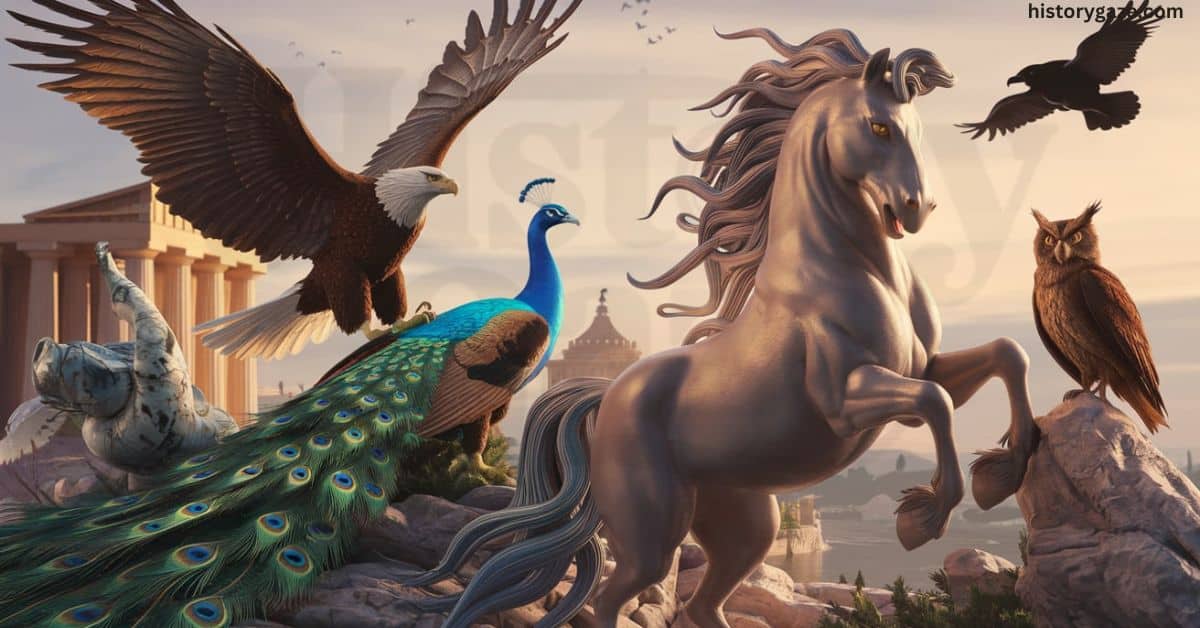In Greek mythology, the “Animals of the Greek Gods” play vital roles as symbols and companions to the divine. The essence of their associated gods and goddesses is embodied by these sacred animals, showcasing their dominion, personality and power. From Zeus’ majestic eagle to Athena’s wise owl, these creatures enrich our understanding of ancient beliefs and values.
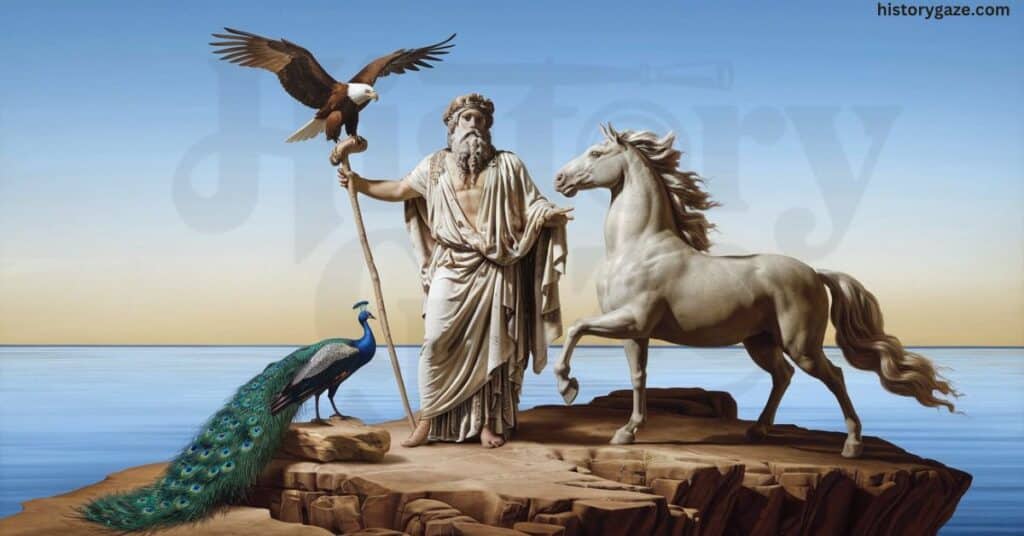
These animals frequently appear in myths, offering insight into the attributes of the gods and their influence over both the natural world and human affairs. Each sacred creature reflects specific qualities that the deities represent, establishing a deep connection between the divine and the earthly.
In this article, we will delve into the sacred animals tied to the most powerful figures in Greek mythology. We’ll examine their significance and explore how these animal symbols shaped ancient culture, enriching the stories and traditions that continue to captivate us today.
The Mighty Eagle of Zeus
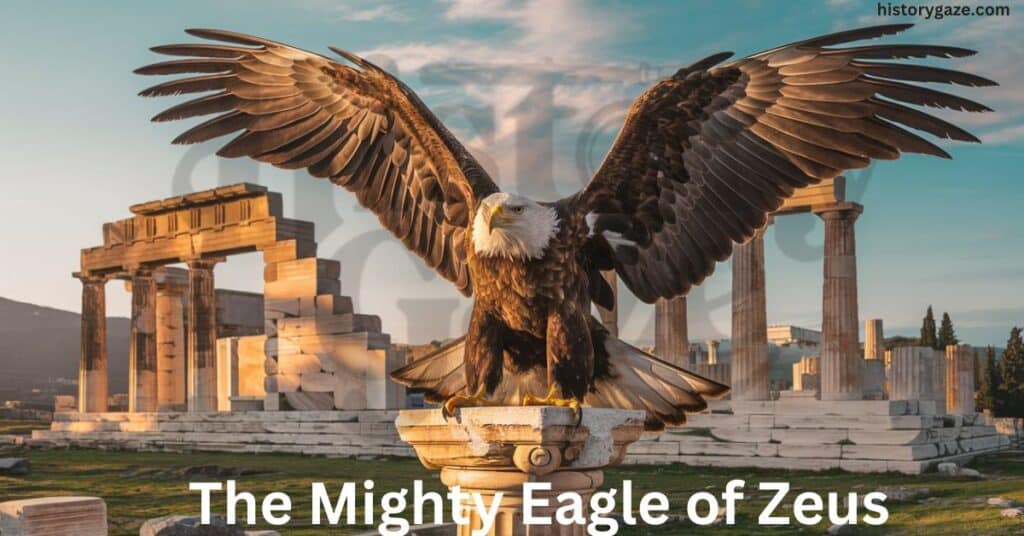
Zeus, known as the King of the Greek Gods, holds dominion over the sky, thunder, and lightning. The eagle, with its strength, speed, and ability to soar at great heights, is his sacred animal. This majestic bird symbolizes Zeus’ power and his watchful gaze over both gods and humans.
The Eagle as a Symbol in Zeus Mythology
The eagle in Zeus mythology is more than a symbol of strength; it represents Zeus’ role as the enforcer of justice and order. In the myth of Prometheus, Zeus sends an eagle to punish the titan who defied him by stealing fire for humanity. Every day, the eagle would devour Prometheus’ liver, emphasizing Zeus’ control over punishment and reward.
In Greek art, artists often depict Zeus with an eagle either perched beside him or flying overhead. This connection became so deep-rooted that many cultures considered the eagle a divine symbol of rulership, reflecting its role in Greek mythology.
Why the Eagle?
- Power: The eagle’s ability to dominate the skies mirrors Zeus’ command over the heavens.
- Vision: The eagle’s sharp sight reflects Zeus’ all-seeing presence.
- Speed: Its swiftness is emblematic of how quickly Zeus can intervene, either to protect or punish.
Zeus’ eagle is not just an animal; it is a manifestation of his authority and sovereignty, ensuring the balance between divine and mortal worlds.
The Peacock of Hera
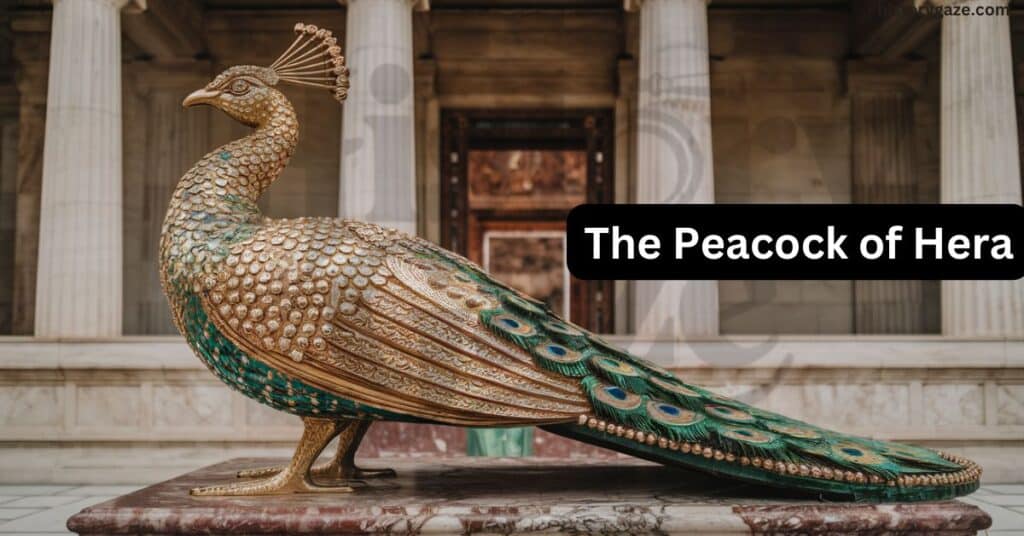
Hera, the queen of the gods and the goddess of marriage and family, is forever linked with the stunning peacock. Known for its vibrant feathers and regal beauty, the peacock is a fitting symbol of Hera’s grandeur and vigilance.
The Story Behind Hera’s Peacock
The association between Hera and the peacock comes from the myth of Argus, a giant with a hundred eyes. When Zeus turned his lover Io into a cow to hide her from Hera, she tasked Argus with guarding Io. After Argus’ death, Hera honored him by placing his eyes on the tail of the peacock, making the bird sacred to her.
Hera Peacock Symbols and Significance
- Pride and beauty: The peacock’s extravagant feathers reflect Hera’s regal and majestic persona.
- Watchfulness: Like Argus’ many eyes, the peacock symbolizes Hera’s vigilance and protectiveness over marriage and family.
In Hera mythology, the peacock reminds us of her role as the eternal guardian of marital fidelity and queenly authority.
Poseidon’s Majestic Horse
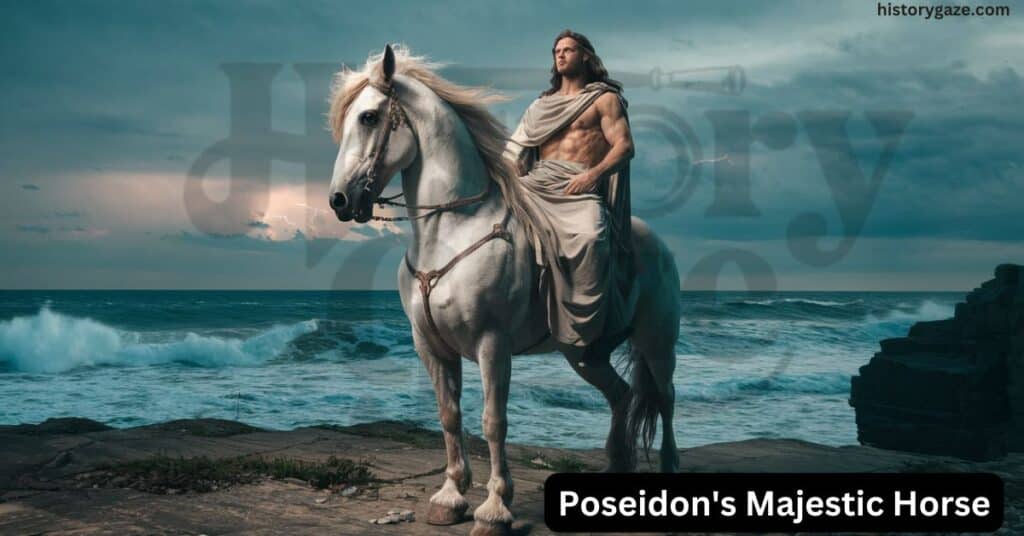
Poseidon is most commonly associated with the ocean and its creatures as the god of the sea. However, people revere the horse the most among his animals, as he is said to have created it himself.
Poseidon’s Connection to Horses and the Sea
According to Poseidon mythology, he was instrumental in creating the first horse. One myth recounts that Poseidon, in competition with Athena for the city of Athens, struck the earth with his trident and brought forth the first horse. While Athena gifted the city the olive tree, Poseidon’s creation of the horse linked him forever to the animal.
The hippocampus, a mythological sea creature part horse and part fish, further ties Poseidon to both horses and his domain of the seas. Depictions of Poseidon often show him riding a chariot pulled by these majestic creatures.
Why the Horse?
- Strength: Horses embody power and freedom, characteristics that resonate with Poseidon’s wild and untamable spirit.
- Speed: Much like the currents of the ocean, horses can move swiftly, representing the god’s control over the seas and its tides.
- Creation: The act of creating the first horse demonstrates Poseidon’s creativity and craftsmanship, linking him to both land and sea.
In both mythology and ancient art, Poseidon’s horse remains a powerful symbol of his mastery over both the oceans and the creatures within.
Athena’s Wise Owl
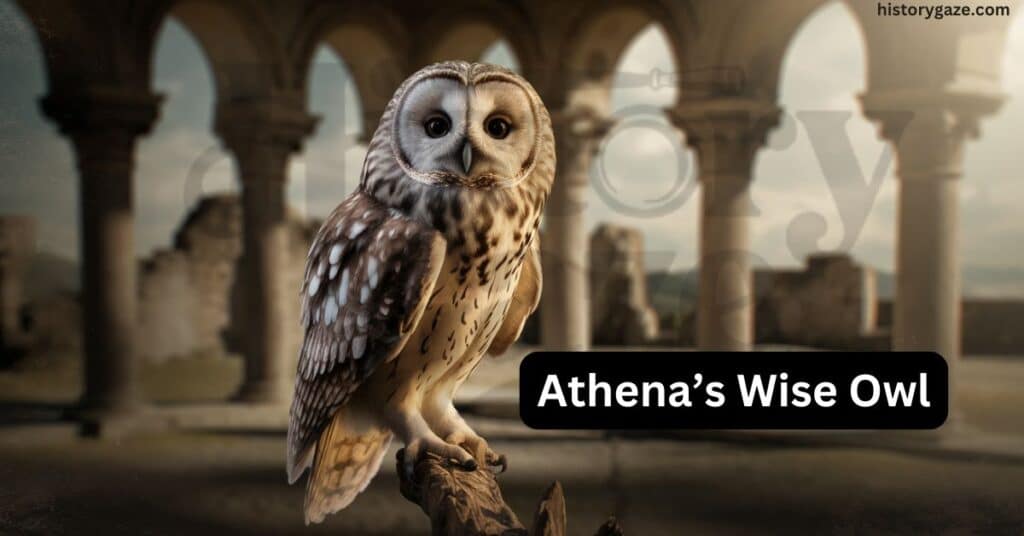
The owl is one of the most enduring symbols of Athena, the goddess of wisdom, war, and strategy. This bird, often depicted with large, all-seeing eyes, is a fitting emblem of Athena’s intellect and judgment.
The Owl in Athena Mythology
In Athena’s mythology, people frequently associate the Greek owl with wisdom and foresight. The city of Athens, named after Athena, adopted the owl as its symbol and often placed it on Athenian coins. Artists frequently depicted Athena with an owl perched on her arm, highlighting her wisdom and strategic prowess.
Why the Owl?
- Wisdom: The owl’s nocturnal vision symbolizes Athena’s ability to see beyond appearances, offering clear-sighted guidance.
- Protection: As a guardian of Athens, the owl represents Athena’s role in protecting both the city and its people.
Athena’s owl remains a timeless symbol of wisdom, intelligence, and the pursuit of knowledge in Greek mythology.
Apollo’s Graceful Raven

The raven, known for its intelligence and mysterious nature, is linked to Apollo, the god of music, prophecy, and the sun. However, in some versions of Apollo mythology, the raven symbolizes the god’s connection to prophecy and foretelling the future.
The Story of Apollo and the Raven
In one tale, Apollo had a raven as his sacred companion. When the raven brought Apollo bad news about his lover, Apollo turned the bird’s once-white feathers black, marking it as a symbol of bad omens. Apollo also associates the raven with his ability to reveal hidden truths and offer foresight.
Why the Raven?
- Prophecy: The raven’s ability to fly at great heights is linked to Apollo’s role in prophecy and truth.
- Intelligence: Ravens are known for their wit, representing Apollo’s intelligence and connection to wisdom.
Apollo’s raven remains a mystical symbol, reflecting his divine power to see what others cannot.
Artemis and the Stag of the Forest
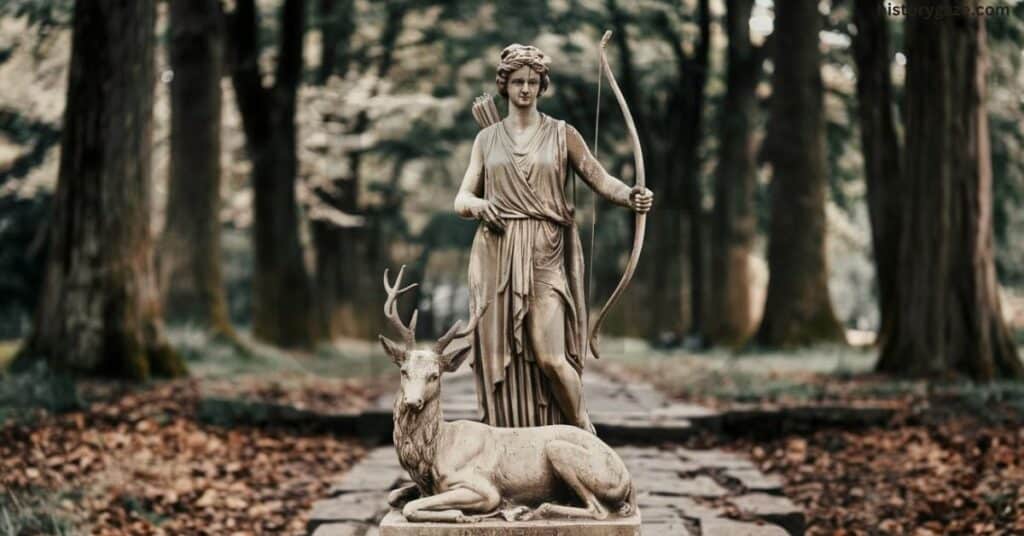
The stag is a powerful symbol of Artemis, the goddess of the hunt and protector of wildlife. Known for its grace and agility, the stag embodies Artemis’ connection to the wilderness and her role as the guardian of the natural world.
Artemis’ Bond with Wildlife
In Artemis mythology, the stag is often seen accompanying the goddess during her hunts. Artemis’ close relationship with the deer reflects her dedication to preserving the balance of nature, as she both hunts and protects the wild.
Why the Stag?
- Grace and strength: The stag’s graceful movements and strength are representative of Artemis’ abilities as a huntress.
- Protection: As the guardian of the forests, the stag reflects Artemis’ protective nature over wildlife.
The deer serves as a reminder of Artemis’ dual role in both preserving and mastering the natural world.
The Winged Companions of Hermes
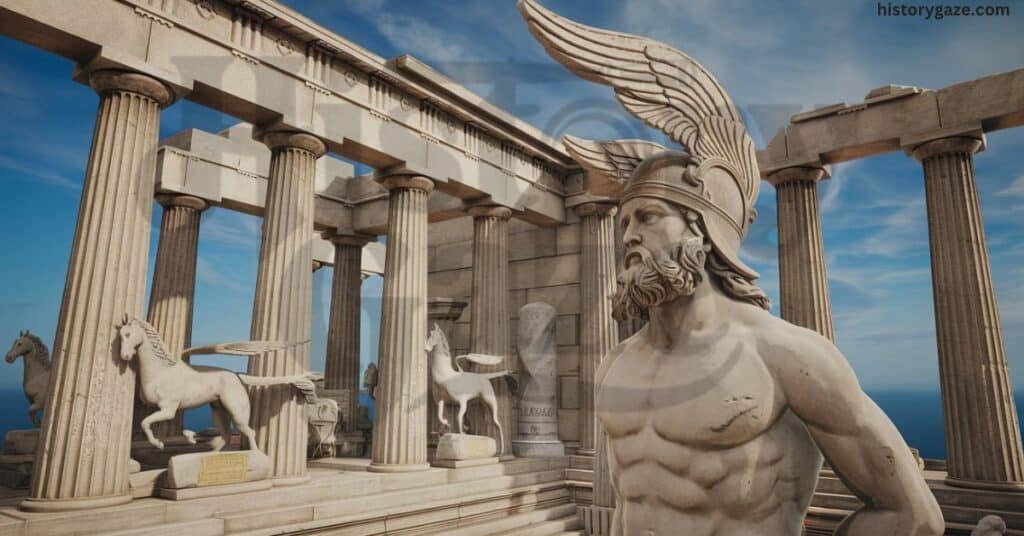
Hermes, the messenger god, is known for his quick wit, speed, and ability to travel between realms. His sacred animals include the tortoise and rooster, both reflecting different aspects of his nature.
The Tortoise and Rooster in Hermes Symbols
In one myth, Hermes uses a tortoise shell to craft the first lyre, showcasing his inventiveness. The tortoise, symbolizing wisdom and perseverance, complements Hermes’ clever and crafty personality.
The rooster, known for its crowing at dawn, is a symbol of Hermes’ role as a guide for travelers, marking the start of a new day and new journeys.
Why the Tortoise and Rooster?
- Innovation: The tortoise reflects Hermes’ creativity and ability to think outside the box.
- Guidance: The rooster’s call at dawn symbolizes Hermes’ role as the god who guides souls and travelers.
Hermes’ animals embody his versatile nature as a guide, messenger, and inventor.
Ares and the Ferocious Dog
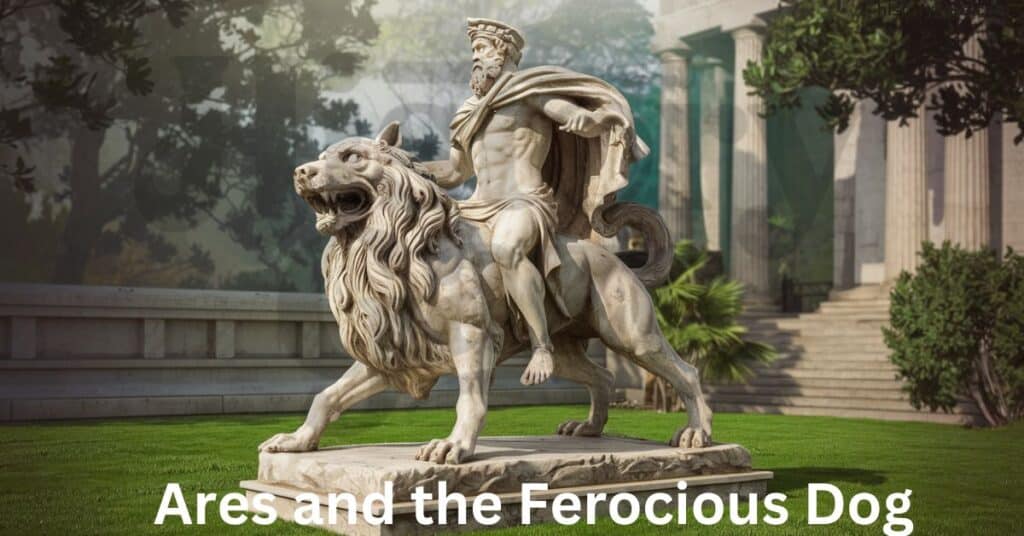
The dog, a fierce and loyal creature, is associated with Ares, the god of war. As a symbol of aggression and loyalty, the dog complements Ares’ nature as a brutal and relentless warrior.
The Dog in Ares Mythology
In Ares mythology, people often see the dog as a reflection of Ares’ combative spirit. Warriors also used dogs in ancient warfare, which further links them to Ares’ domain over battle and conflict.
Why the Dog?
- Loyalty: The dog’s unwavering loyalty mirrors the commitment of soldiers to their cause.
- Aggression: As a fierce protector, the dog symbolizes Ares’ ferociousness on the battlefield.
Ares’ dog serves as a symbol of both aggression and protection, embodying the dual nature of war.
The Serpents of Demeter
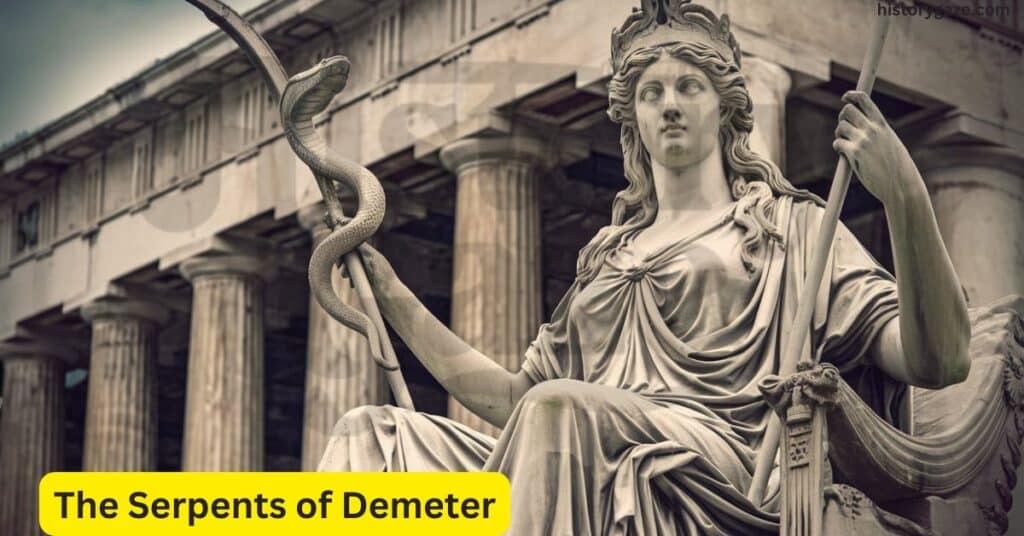
The serpent, often associated with fertility and renewal, is a sacred animal of Demeter, the goddess of harvest and agriculture.
The Role of the Serpent in Demeter Mythology
In Demeter mythology, serpents are linked to the earth and its cycles of life and death. They often appear in rituals related to fertility, agriculture, and the renewal of the land. The serpent represents Demeter’s connection to the earth’s fertility and the continual cycle of growth and decay.
Why the Serpent?
- Fertility: Serpents are often associated with the earth’s fertility, mirroring Demeter’s role as the goddess of agriculture.
- Renewal: The shedding of the serpent’s skin symbolizes the cycles of life, death, and rebirth, much like the agricultural seasons.
Demeter’s serpents serve as a powerful reminder of the connection between life, growth, and the cycles of the earth.
Hades and His Guarding Three-Headed Hound
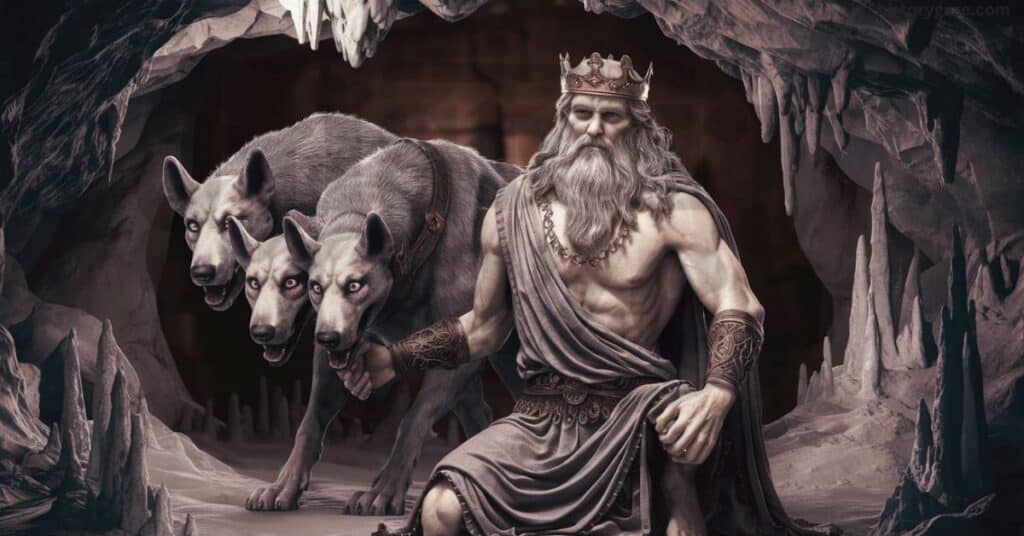
Hades, the ruler of the underworld, often depicts Cerberus, the three-headed hound that guards the gates of the underworld. Cerberus is a fierce and loyal companion, preventing the souls of the dead from escaping.
Cerberus in Hades Symbols
In Hades mythology, Cerberus stands as a symbol of the god’s power over life and death. People often sacrifice the black ram, another of Hades’ sacred animals, in rituals to appease the god of the dead.
Why Cerberus and the Black Ram?
- Guardianship: Cerberus represents Hades’ role as the protector of the underworld, ensuring that no souls escape.
- Sacrifice: The black ram symbolizes the reverence and fear mortals held for Hades and his domain.
Hades’ animals reflect his authority and the unbreakable boundary between the world of the living and the dead.
Aphrodite’s Dove of Love
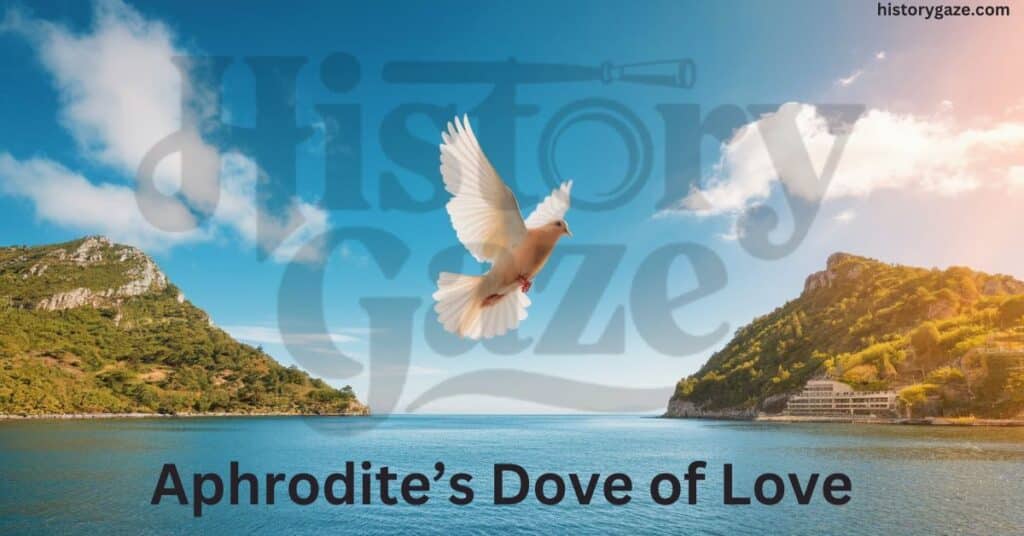
The dove, a symbol of peace, beauty, and love, is the sacred animal of Aphrodite, the goddess of love and beauty. Known for its gentle and nurturing nature, the dove perfectly encapsulates Aphrodite’s domain over romance and affection.
The Role of the Dove in Aphrodite Symbols
The dove is often seen accompanying Aphrodite, symbolizing her nurturing and loving nature. In mythology, the dove represents peace and harmony, two qualities closely associated with Aphrodite’s influence over relationships.
Why the Dove?
- Love and beauty: The dove’s gentle nature reflects Aphrodite’s domain over love, beauty, and affection.
- Peace: Doves are often seen as symbols of peace, reflecting Aphrodite’s role in maintaining harmony in relationships.
Aphrodite’s dove remains a powerful symbol of love and tranquility in Greek mythology.
Dionysus and the Wild Panther
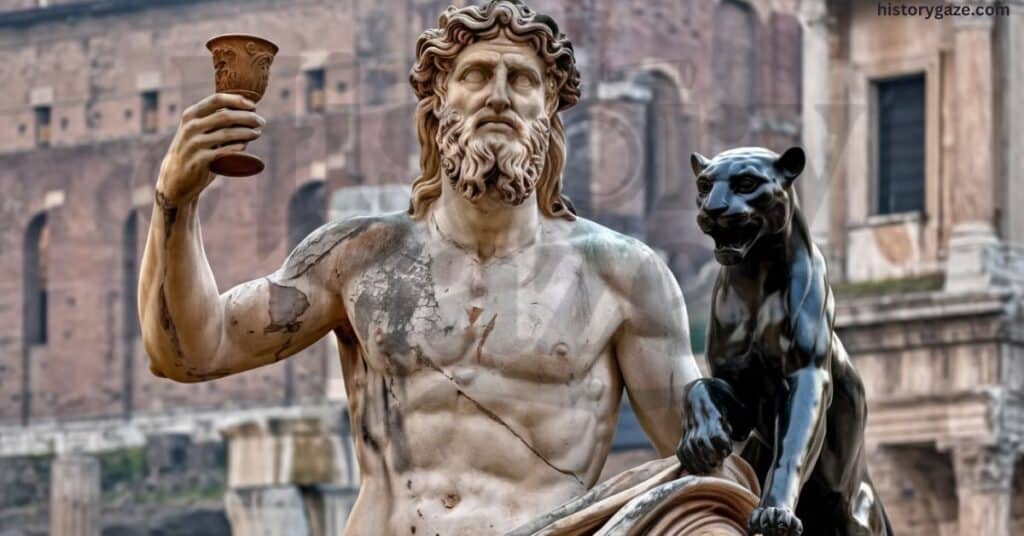
The panther, a wild and untamed creature, is sacred to Dionysus, the god of wine, revelry, and ecstasy. Known for its power and unpredictability, the panther symbolizes Dionysus’ wild and liberating influence.
The Panther in Dionysus Mythology
In Dionysus mythology, the panther is often depicted pulling the god’s chariot, representing his ability to bring both joy and chaos. The panther’s ferocity and freedom mirror the intoxicating and unpredictable nature of Dionysus’ domain.
Why the Panther?
- Wildness: The panther’s wild nature reflects Dionysus’ ability to break free from societal constraints.
- Power: The panther’s strength symbolizes the god’s influence over both the physical and emotional realms.
Dionysus’ panther is a fitting representation of the god’s untamed spirit and his ability to bring both joy and madness.
These sacred animals of the Greek gods and goddesses offer a deeper understanding of the divine figures in Greek mythology. Each animal, from Zeus’ eagle to Aphrodite’s dove, represents key aspects of the gods’ personalities, powers, and roles within the ancient world. These animal symbols continue to inspire and fascinate, reminding us of the rich tapestry of myths that have shaped human culture for millennia.
Conclusion
In summary, the sacred animals of the Greek gods and goddesses reveal the rich symbolism embedded in Greek mythology. Each animal connects deeply to the divine figures, illustrating their unique traits and powers.
These animal symbols continue to resonate today, reminding us of the timeless nature of these myths. They offer insight into the beliefs of ancient Greeks and their reverence for the natural world intertwined with the divine.

Chloe Decker is a skilled writer for History Gaze, passionate about making history engaging and accessible. She brings the past to life with clear, concise narratives that appeal to both history lovers and casual readers. Through her work, Chloe reveals the key events and figures that shaped the world, helping readers connect with history in a meaningful way.
